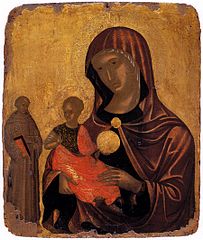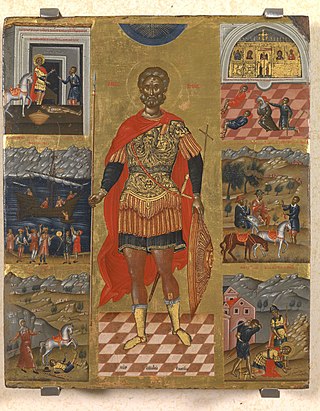
Cretan School describes an important school of icon painting, under the umbrella of post-Byzantine art, which flourished while Crete was under Venetian rule during the late Middle Ages, reaching its climax after the Fall of Constantinople, becoming the central force in Greek painting during the 15th, 16th and 17th centuries. The Cretan artists developed a particular style of painting under the influence of both Eastern and Western artistic traditions and movements; the most famous product of the school, El Greco, was the most successful of the many artists who tried to build a career in Western Europe, and also the one who left the Byzantine style farthest behind him in his later career.

The Heptanese School of painting succeeded the Cretan School as the leading school of Greek post-Byzantine painting after Crete fell to the Ottomans in 1669. Like the Cretan school, it combined Byzantine traditions with an increasing Western European artistic influence and also saw the first significant depiction of secular subjects. The school was based in the Ionian Islands, which were not part of Ottoman Greece, from the middle of the 17th century until the middle of the 19th century. The center of Greek art migrated urgently to the Ionian islands but countless Greek artists were influenced by the school including the ones living throughout the Greek communities in the Ottoman Empire and elsewhere in the world.

San Giorgio dei Greci is a church in the sestiere (neighborhood) of Castello, Venice, northern Italy. It was the center of the Scuola dei Greci, the Confraternity of the Greeks in Venice. Around this period there was a similar church in Naples called Santi Pietro e Paolo dei Greci. There was also a Greek Brotherhood of Naples.

Emmanuel Tzanes, also known as BounialisEmmanuel Tzane-Bounialis, Emmanuel Zane, and Emmanuel Tzane. He was a Greek Renaissance painter. He was an author, clergyman, painter, and educator. He was the parish priest of the church of San Giorgio dei Greci. An important Greek church in Venice. He was affiliated with the Flanginian School of the Greek Confraternity in Venice. He was a prominent painter. His known works number over 130 pieces. His works can be found in public foundations, private collections, churches and monasteries in Greece. He collaborated with many artists namely Philotheos Skoufos. Both artists were members of the Cretan School. He was influenced by the Venetian school. Emmanuel's brothers were famous painter Konstantinos Tzanes and poet Marinos Tzanes. His most popular work is The Holy Towel finished in 1659.

Theodore Poulakis was a Greek Renaissance painter and teacher. He is considered the father of the Heptanese School and one of the most prolific painters of Venetian Crete. Poulakis was a member of the Cretan School, his contemporary was Emmanuel Tzanes. Emmanuel Tzanes and Poulakis were active painters of the Cretan School until Candia, went to war with the Ottomans around 1649. Candia finally fell after twenty years of siege in 1669. Poulakis settled on the island of Corfu. Stephanos Tzangarolas was another famous painter in Corfu around the same period. Poulakis's works are likened to Andreas Pavias and Georgios Klontzas. Poulakis works exhibit qualities of the Venetian school. Over 130 of his paintings have survived and can be found all over the world.

Andreas Ritzos also known as (Rico, Ricio, Rizo). He was a Greek icon painter, from Crete. Ritzos is considered one of the founding fathers of the Cretan School. He was affiliated with Angelos Akotantos. Most of his work stylistically follows the traditional maniera greca. His children, grandchildren, and great-grandchildren were also painters. He was one of the most influential painters of the Cretan School along with Andreas Pavias and Angelos Akotantos. He influenced the works of Georgios Klontzas, Nikolaos Tzafouris, Theophanes the Cretan, Michael Damaskinos and El Greco. According to the Institute for Neohellenic Research, sixty of his paintings have survived.

Nikolaos Tzafouris(Greek: Νικόλαος Ζαφούρης η Τζαφούρης) 1468-1501), also Niccolo, Niccolò, Niccolö, Zafuri, Zafuris, was a Greek Renaissance painter. He was one of the founders of the Cretan School. He was influenced by Angelos Akotantos. His works influenced Emmanuel Tzanes, Elias Moskos, Georgios Klontzas and Theodoros Poulakis. Tzafouris was one of the most respected artists in Crete. His most notable work is Madre della Consolazione. The painting exhibits a combination of Byzantine and Italian styles. Another notable painter in Crete around the same time was Andreas Pavias. According to the Institute of Neohellenic Research, thirteen paintings are attributed to Tzafouris.

Cathedral of Saint Jacob and Saint Christopher (Greek: Ιερός Καθολικός Μητροπολιτικός Ναός and ) is the seat of the Roman Catholic Archdiocese of Corfu, Zakynthos and Cephalonia. The church houses an extensive collection of paintings one of the most important is the Virgin Vrefokratousa Enthroned by Konstantinos Tzanes painted in 1654.

Konstantinos Tzanes was a Greek Renaissance painter. He was a painter in Crete and Venice. His brother Emmanuel Tzanes was the parish priest of the church of San Giorgio dei Greci. Emmanuel Tzanes was also a famous painter and author. Konstantinos followed the Venetian style and in some instances completely broke from the maniera greca. His other brother Marinos Tzanes was a famous poet. Konstantinos's work influenced both Greek and Italian Painters. His most popular work is the painting by Mary Magdalene which is at the Greek Institute in Venice.
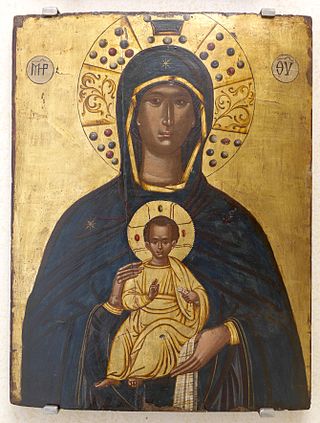
Thomas Bathas was a Greek painter, educator, and Vikar. He employed the maniera greca in some of his work but he also broke from tradition by employing the Venetian style. He traveled around the Venetian Empire going from Heraklion to Corfu and Venice. He was a prominent member of the Greek Confraternity in Venice. He was friends with Gabriel Severus, Metropolitan of Philadelphia. He was very popular among both Greek and Italian patrons. He influenced the works of countless artists both Italian and Greek. Some of his works are in San Giorgio dei Greci and the Hellenic Institute of Venice. Emmanuel Tzanes, Konstantinos Tzanes, Ioannis Moskos, and Philotheos Skoufos were some Greek artists influenced by his work. One of his students was the famous painter Emmanuel Tzanfournaris. He left him a fortune in his will. His most famous works include: Portrait of the Metropolitan of Philadelphia Gabriel Severus and Virgin and Child Enthroned. Twenty of his paintings have survived.
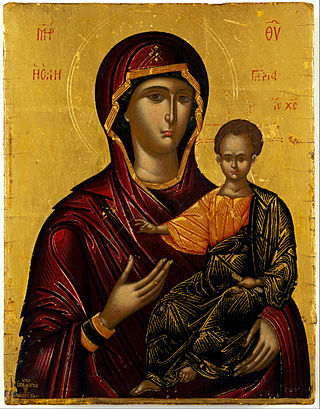
Emmanuel Lampardos, also known as Emmanouil Lampardos and Manolitzis. He was a Cretan Renaissance painter. Emmanuel and his nephew Emmanuel Lampardos have been very difficult to distinguish because they were active painters around the same period. Countless Greek and Italian artists emulated the famous painters. The name Lampardos was very notable in reference to Cretan art. The family was affiliated with famous painters Franghias Kavertzas and Tzortzi Papadopoulo. Lampardos emulated Georgios Klontzas, Michael Damaskinos, Angelos Akotantos, Andreas Pavias, Andreas Ritzos and Nikolaos Tzafouris. His style was the typical maniera greca with a strong Venetian influence. Countless images of the virgin and child have survived. Lampardos influenced Franghias Kavertzas, Emmanuel Tzanes, Philotheos Skoufos Elias Moskos, Leos Moskos, Ioannis Moskos and Emmanuel Tzanfournaris. Over fifty-six icons have been attributed to Lampardos.

Ioannis Tzen also known as Ioannis Dzenos, was a 17th-century Greek baroque painter. He was active on the Ionian islands and a prominent member of the local school. He also represented Crete towards the end of the Cretan School. His painting style reflects an affiliation with Emmanuel Tzanes. He was active on the island Corfu. Greek painters affiliated with the same island active during the same period were Theodore Poulakis, Stephanos Tzangarolas. Fifteen of his works have survived. His most notable work is a painting of the Virgin and Child.

Mary Magdalene is a tempera painting by Konstantinos Tzanes. Tzanes was a Greek painter active during the late Cretan Renaissance. Tzanes and his brothers migrated from Crete to Venice. His brother was famous painter Emmanuel Tzanes. They were both active during the 17th century. Twenty-one of his paintings survived. Both brothers uniquely contributed to the maniera greca. They made drastic improvements to the style redefining space and color. Their work is comparable to Michael Damaskinos.
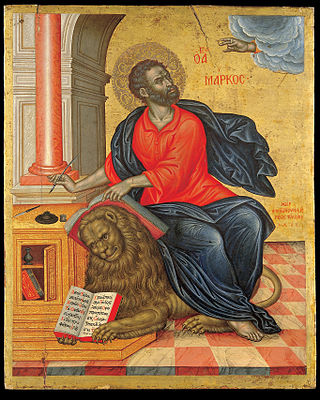
Saint Mark is a tempera painting by Emmanuel Tzanes. Tzanes was a Cretan painter who migrated to Corfu and Venice. He settled in Venice with his brothers Konstantinos Tzanes and poet Marinos Tzanes. Konstantinos was a famous painter. Their combined existing works number over 150. Emmanuel replaced famous Greek painter Philotheos Skoufos as the priest of San Giorgio De Greco.
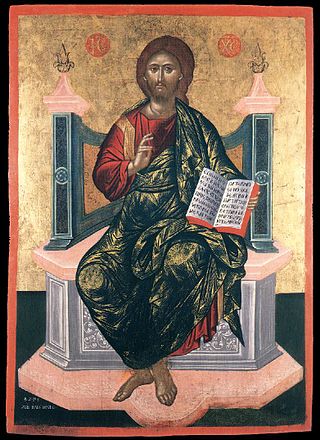
Christ Enthroned was a tempera painting created by Elias Moskos. Moskos was a representative of the Late Cretan School. The artist was also associated with the Heptanese School due to his migration to Zakinthos and the transition of his painting style. Moskos also taught painting. Most of his students became church committee members. Church committees were responsible for commissioning paintings. He was active from 1645 to 1687 on the islands of Crete, Zakynthos, and Kefalonia. Fifty-two of his works survived, over half of them were signed. Two other painters named Moskos were active during the same period Ioannis Moskos and Leos Moskos.

Christ Enthroned is a tempera icon by Emmanuel Tzanes, a Greek painter of the Late Cretan School. It is currently at the Byzantine & Christian Museum in Athens.
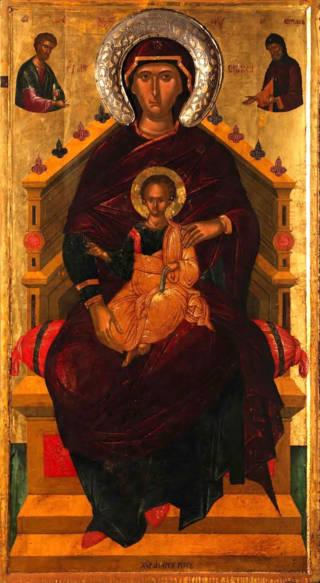
The Virgin Pantanassa is a tempera painting by Andreas Ritzos. Ritzos was a Greek painter active on the island of Crete. He flourished from 1435 to 1492. The painter has an existing catalog of over sixty works attributed to him. He signed his works in both Greek and Latin. He is one of the most influential painters of the Cretan Renaissance. He painted in the traditional Greek-Italian Byzantine style. His work was also heavily influenced by Venetian painting. His teacher was Angelos Akotantos. He was also affiliated with Andreas Pavias. His son was famous Greek painter Nikolaos Ritzos. Ritzo's Italian contemporaries were Paolo Uccello and Fra Angelico. They all painted a mixture of the Greek-Italian Byzantine and Italian Renaissance styles. The art of Crete was heavily influenced by the founder of the Venetian school Paolo Veneziano.

The Holy Towel is a tempera painting completed by Emmanuel Tzanes. He was a representative of the Late Cretan School and the Heptanese School. His one brother was famous painter and poet Marinos Tzanes. His other brother was famous painter Konstantinos Tzanes. One hundred thirty works of art are attributed to Emmanuel. He is one of the most important Greek painters of the 17th century along with Theodoros Poulakis. He was from Rethymno Crete. He was active from 1625 to 1690. He painted for over sixty-five years. He was the priest of San Giorgio dei Greci in Venice for thirty years.

The Incredulity of Saint Thomas is a tempera painting created by Greek painter Emmanuel Tzanes. Tzanes features a catalog of artwork numbering over one hundred works. He was one of the most prolific artists of the 1600s painting in Crete, Corfu, and Venice. His two brothers Marinos Tzanes and Konstantinos Tzanes were also famous painters but Marinos is more well known for his famous poem The Cretan War Ο Κρητικός Πόλεμος. All three artists were members of the Late Cretan School and early Heptanese School (painting) they were known for participating in the movement that integrated Flemish engravings into the Greek and Italian art world.

The Virgin and Child Enthroned is a tempera painting created by Spyridon Romas. He was a Greek painter from the island of Corfu and a prominent member of the Heptanese School active from 1745 to 1786 in Corfu, Lecce, Livorno, and London. Twenty-five of his works survived according to research completed by the Hellenic Institute. One of few Greek painters that changed his style completely Romas transitioned from the Heptanese School to the British style of painting. He traveled to London, England around 1770, and remained in the country until his death. Romas painted several portraits but also maintained art. An important iconostasis containing most of his works is preserved in Livorno, Italy at the Museo della Città di Livorno.




